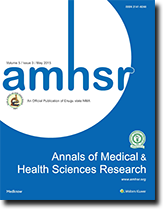

Background: NOM is considered a treatment option for all hemodynamically stable patients without peritoneal signs and many recent reports reveal success rates of 80%. In this study we evaluated the feasibility and safety of NOM of BAT in our hospital. Methods: This retrospective study comprises 86 patients with BAT who were admitted over a 3 year period. NOM was applied in 82.93% (34 patients) of all BATs with a failure rate of 17.07% (7 patients). Of these 7 patients of NOM failure were clubbed with OM group in order to perform statistical comparison. Finally comparison was done between NOM (n=64) and OM (n=22) group. The comparison was done between NOM and OM group in terms of demographic, medical history (co-morbidities), mode of injury, hemodynamic status, and organs injured, injury grading, length of hospital stay, morbidity and mortality. Results: Most of the patients were young adults (2045 years) with mean age being 32.45 years and age ranging between 16-62 years. The commonest cause of BAT (n=78, 90.69%) was Road traffic accident (RTA). No significant differences were observed between NOM and OM group in relation with age, sex, time of presentation (hours), co-morbidities and mechanism of injury. Injury severity score (ISS), hematocrit, hemodynamic status and blood transfusion were significantly different between NOM and operative group. NOM has a significant decrease in length of hospital stay, ICU admission and morbidity compared to patients who underwent surgery. NOM failure occurred in 4 patients with splenic injury and 1 patient with liver injury and 2 patients with hollow viscous perforation.6 patients were died in OM group. The success rate of NOM was 95.3%. Conclusion: NOM for BAT was found to be highly successful and safe. The patient with hemodynamically stable or easily stabilized trauma may be admitted to a non-ICU unit, with close monitoring of vital signs and regular clinical examinations.
Select your language of interest to view the total content in your interested language
Annals of Medical and Health Sciences Research received 24805 citations as per google scholar report
 The Annals of Medical and Health Sciences Research is a monthly multidisciplinary medical journal.
The Annals of Medical and Health Sciences Research is a monthly multidisciplinary medical journal.